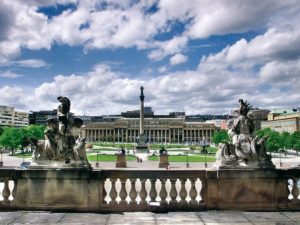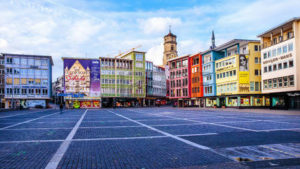Cars, culture and cuisine in Stuttgart
Even if, like me, you see cars purely as a way of getting from A to B you still cannot be impressed with two of Stuttgart’s favourite tourist attractions, two magnificent modern museums and their shiny exhibits, one for Porsche and one for Mercedez-Benz. But don’t get the impression cars are the only attraction to this city with its industrial reputation as the ‘cradle of the automobile‘. The sixth largest city in Germany, the capital of Baden-Württemberg, is one of the most surprising as it is spreads across gentle hills, many with vineyards, and incorporates parks and gardens.
It also has an idyllic location being about an hour from the Black Forest and the Swabian Jura, situated between vineyards and thick woodland. Being one of the most prosperous areas of Germany, thanks in no small part to the automotive industry, the city is an ideal holiday destination for those who enjoy the good life: beautiful architecture, palaces, excellent museums, a vibrant classic al and contemporary performing arts scene, strong regional cuisine and fine local wines.
While those car museums are examples of stunning modern architecture produced by the wealth of modern industries, Stuttgart also boasts a wealth of 18th and 19th century buildings. In 1803, Stuttgart was proclaimed capital of the Electorate of Württemberg until Napoleon Bonaparte’s break-up of the Holy Roman Empire in 1805 when Stuttgart became capital of the Kingdom of Württemberg. A grand building scheme was inaugurated to create a city fit for a king and today these form the beautiful physical structure of modern Stuttgart, many surrounded by exquisite parks, formal gardens.
These appealing buildings include the Stuttgart State Opera is one of Europe’s foremost opera houses and at the same time a branch of Europe’s largest tripartite theatre, while another houses the Stuttgart State Gallery. The original building has been marvellously extended with new galleries added in 2005 to house a collection of international standing from Renoir and Monet, to Klee and Picasso.
But this is a city where you can spend enjoyable afternoons just strolling around outdoors in the city centre, taking in other impressive buildings such as the Hohenheim Palace, surrounded by botanical gardens and an English park and the magnificent Solitude Palace and hunting lodge in Stuttgart comprising one of the outstanding architectural ensembles of the 18th century.
Such delights aside, some people come to the city just to see those motor museums. The Mercedez-Benz Museum is far more than just a home for 125 years of automotive history. The new museum building opened to the public in 2006 and is now the most visited museum in Stuttgart with nearly half a million visitors each year. Architecturally almost as impressive of the collection of cars inside, the Porsche Museum looks as if it is about to take off. Around 80 vehicles and numerous smaller exhibits are on display but look don’t touch!
While the city has as wide a range of restaurants as you would expect in a wealthy, cosmopolitan centre, be sure to try the region’s Swabian cuisine including the speciality noodle, spaetzle, which is boiled in water or broth then pan fried in butter and served as a side dish. Stuttgart also has an enjoyable café culture so by day you can sit in squares or in those parks such as outside Neues Schloss at Schlossplatz , watching the world go by, perhaps with a glass of local wine grown and produced just kilometres away.
Stuttgart is the ideal place for a wine tour with the vines stretching up the slopes of the Neckar Valley. There are wine tasting tours available and if you are on a longer trip you can explore South West Germany’s many wine trails, from the Kaiserstuhl in the west to Lake Constance in the east, along the Tauber and Neckar valleys. Highly recommended is a visit to the Kessler in Esslingen, the oldest German sekt winery, founded by Georg Christian von Kessler in 1826 after learning how to make sparkling wine at the Veuve Cliquot estate in the Champagne region.
For more information of the region, festival and cultural events, accommodation and travel possibilities contact the German National Tourism Board. www.germany.travel/en/index.html

